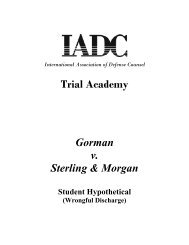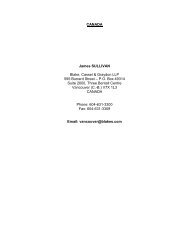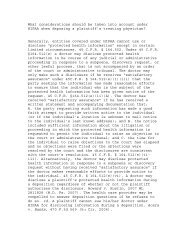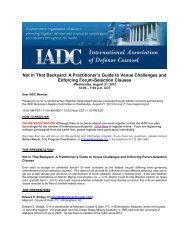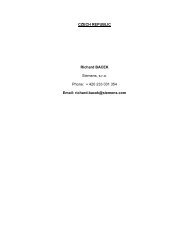Defense Counsel Journal - International Association of Defense ...
Defense Counsel Journal - International Association of Defense ...
Defense Counsel Journal - International Association of Defense ...
Create successful ePaper yourself
Turn your PDF publications into a flip-book with our unique Google optimized e-Paper software.
Raising the Ro<strong>of</strong> Page 469such risks as a matter <strong>of</strong>insurance underwriting. 7Quoting Dean Roger Henderson,who espoused the principle in theNebraska Law Review, the court noted:The risk intended to be insured isthe possibility that the goods,products or work <strong>of</strong> the insured,once relinquished or completed,will cause bodily injury ordamage to property other than tothe product or completed workitself, and for which the insuredmay be found liable. The insured,as a source <strong>of</strong> goods or services,may be liable as a matter <strong>of</strong>contract law to make good onproducts or work which isdefective or otherwise unsuitablebecause it is lacking in somecapacity. This may even extendto an obligation to completelyreplace or rebuild the deficientproduct or work. This liability,however, is not what thecoverages in question aredesigned to protect against. Thecoverage is for tort liability forphysical damages to others andnot for contractual liability <strong>of</strong> theinsured for economic lossbecause the product or completedwork is not that for which thedamaged person bargained.An illustration <strong>of</strong> thisfundamental point may serve tomark the boundaries between“business risks” and occurrences7 Weedo, 405 A.2d at 791.giving rise to insurable liability.When a craftsman applies stuccoto an exterior wall <strong>of</strong> a home in afaulty manner and discoloration,peeling and chipping result, thepoorly-performed work willperforce have to be replaced orrepaired by the tradesman or by asurety. On the other hand, shouldthe stucco peel and fall from thewall, and thereby cause injury tothe homeowner or his neighborstanding below or to a passingautomobile, an occurrence <strong>of</strong>harm arises which is the propersubject <strong>of</strong> risk-sharing asprovided by the type <strong>of</strong> policybefore us in this case. 8Another prime example <strong>of</strong> theextreme on the “occurrence” spectrum isthe recent decision <strong>of</strong> the KentuckySupreme Court in Cincinnati Insurance v.Motorists Mutual Insurance. 9 InMotorists Mutual, the Court considered aclaim against the insured generalcontractor brought by a couple whichpurchased a home built by the insured(the decision is silent regarding whetherthe contractor used subcontractors toperform any <strong>of</strong> the work). Relying on thefortuity principle, the Court held simply:Inherent in the plain meaning <strong>of</strong>“accident” is the doctrine <strong>of</strong>fortuity. Indeed, “[t]he fortuityprinciple is central to the notion<strong>of</strong> what constitutes insurance....”8 Roger Henderson, Insurance Protection forProducts Liability and Completed Operations,What Every Lawyer Should Know, 50 NEB. L.REV. 415, 441 (1971).9 306 S.W.3d 69 (Ky. 2010).



